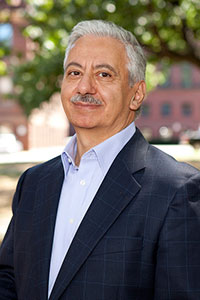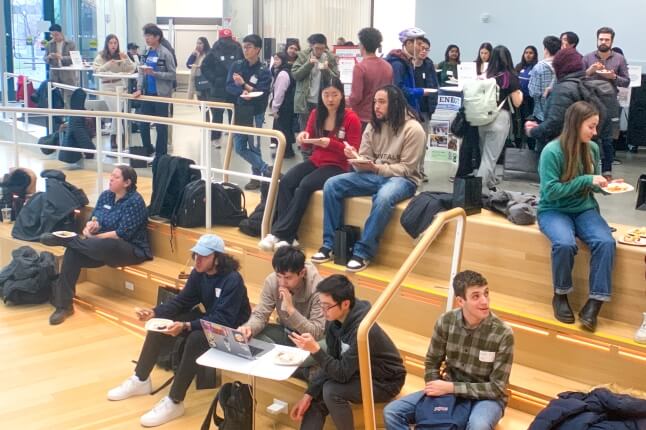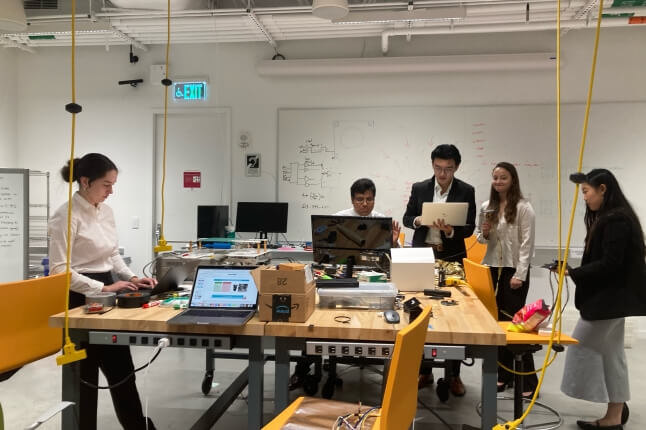News
The Untethered RoboBee
Changes to the Robobee — including an additional pair of wings and improvements to the actuators and transmission ratio — made the vehicle more efficient and allowed the addition of solar cells and an electronics panel. This Robobee is the first to fly without a power cord and is the lightest, untethered vehicle to achieve sustained flight. (Image courtesy of the Harvard Microrobotics Lab/Harvard SEAS)
Rats on campus, disruptive noise pollution, and costly deep-sea research seem to have nothing in common—except that they could all be solved using an engineering design approach.
Students in the Harvard John A. Paulson School of Engineering and Applied Sciences course Engineering Problem Solving and Design Project (ES 96) did just that, applying their engineering know-how, in collaboration with real-world clients, to come up with actionable solutions.
The course requires students to analyze a challenge as a broad system and identify social, economic, ethical, technical, and sustainable components; examine systems feedback and enforcing loops to determine root causes of the issues; and investigate and design different solutions that satisfy the boundaries that surround the challenge, explained Fawwaz Habbal, Executive Dean for Education and Research, who co-taught the course with Kelly Miller, Senior Preceptor in Applied Physics, Nabil Harfoush, Visiting Associate Professor in Engineering Sciences, and Peter Stark, Lecturer on Engineering Sciences.
“With such unique and thorough experience, students become more prepared to engage in future challenges and exercise their leadership to address and possibly resolve important human issues,” Habbal said. “This year, the students did an amazing job finding root causes for three different challenges, and together found exciting solutions. The clients were excited by the solutions and will implement some of them. It was an exciting experience for the students, rewarding for the clients, and rewarding for the instructors who observed the students’ growth and maturity.”
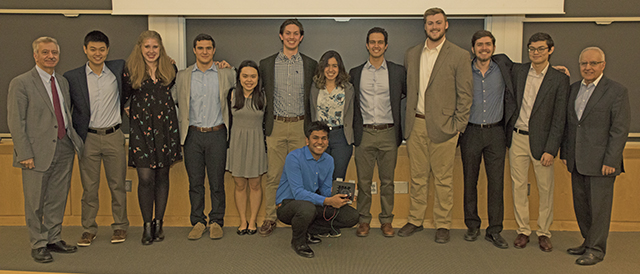
Noise Pollution Challenge
The Harvard University Dining Services (HUDS) loading dock is a busy place, with a steady stream of trucks entering and leaving to drop off or pick up food that is used to serve 25,000 meals each day. With so much activity, much of it occurring in the early morning hours, students living in houses adjacent to the loading dock—Eliot, Kirkland, Winthrop, and Lowell—have voiced concerns about noise that disrupts their studying and sleep. One ES 96 section worked with HUDS, identifying ways to reduce noise without negatively affecting operations.
After studying the loading dock traffic and noise levels, the students came up with several short-term and long-term solutions. In the long-term, they proposed changing the layouts of Eliot and Kirkland house, in conjunction with the house renewal project, so fewer bedroom windows face the loading dock. They also proposed keeping storm windows in place, even after double-paned windows are installed. The students found that maintaining a five-inch gap between the storm window and dual-paned windows reduced noise by nearly 60 percent, for an additional cost of $200 per storm window.
In the short-term, the students suggested coating flaps of truck beds to reduce noise when they slam against the loading dock deck. By adding a foam rubber coating to the end of a flap, and pouring silicone onto the deck to provide a soft landing space, the students were able to reduce noise levels from 100 to 86 decibels. They also developed a weatherproof box, containing acoustic foam and dense sound panels, to place over a truck’s back up alarm, which reduced noise levels from 102 to 88 decibels.
“The biggest challenges we faced were learning how to work efficiently and effectively over the course of the project,” said Jessica Klusty, S.B. ’20, a bioengineering concentrator. We were a group of 11 people, working together towards one common goal, but there were fluctuating sub-groups that changed week to week. This presented problems with coordination and communication in the beginning, but I believe it made us stronger over the long run. The most rewarding part of this project was seeing that, in the end, we actually helped our client and the changes we suggested were immediately going into effect.”
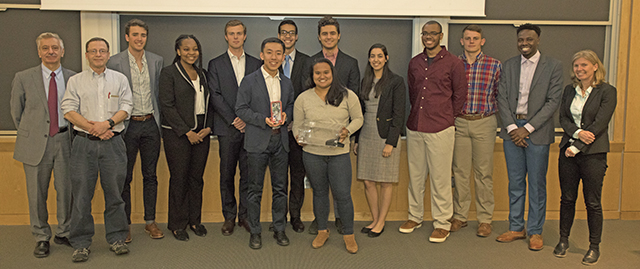
Containing the Pest Problem at Harvard
Harvard’s office of Environmental Health and Safety receives hundreds of reports each week about pests on campus, mostly rats and mice that students spot rummaging through trashcans or skittering around buildings in search of food. The sanitary and reputational issues posed by rats on campus is a serious concern, but current actions, including artificial rocks that contain poison, video surveillance, and pest-proofing trash cans, do not keep up with the pace of the problem. One ES 96 section set out to improve the effectiveness of pest control measures and decrease pest access to food sources at Harvard.
The students studied a number of solutions, and even (briefly) considered introducing predatory animals on campus, before opting to engineer a more robust rat trap and improve Harvard’s pest report database. The students developed a trap that sits underneath the lid of a trash can; a pipe through the can lid offers rats a one-way entrance into the trap. Once inside the sealed box, a T-Rex Rat Trap kills the rat. A magnetic mechanism the students developed enables a worker to open the box, empty the unlucky rat into the trash can, then close the box and reset the trap with the push of one button.
The students also took a data-driven approach to the problem by developing a web app to consolidate pest reports EHS receives on a daily or weekly basis. Individuals use the app to report pest sightings, which are automatically populated into a database and onto a map that shows pest hot spots around campus. In addition to taking data from human reports, the app is also designed to receive information from the pest detection device the students developed. The device uses an infrared sensor to detect rats that pass nearby, then uses GPS data to automatically log the location in the app’s database and map, streamlining the pest reporting process.
“My instinct when faced with a tough problem is usually to jump right into figuring out how to solve it, but one thing this class did well was to force me not to do that. We spent the first few weeks of the semester defining the problem, rather than solving it,” said Charlie Colt-Simonds, S.B. ’20, an electrical engineering concentrator. “At first, this process was incredibly frustrating, but I soon realized that there was a lot to learn about the problem itself before we could even start thinking about solutions. It taught me to take my time when first approaching a problem, to make sure I understand it fully before jumping to solutions.”
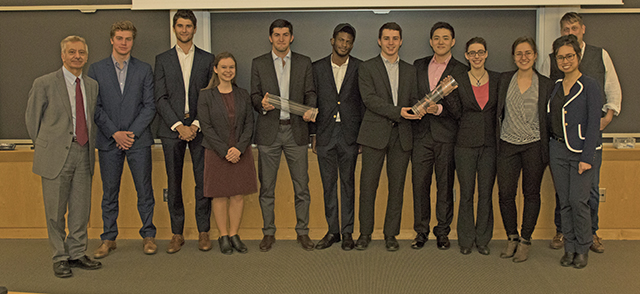
An Intelligently Designed, Inexpensive Pressure Vessel
The lab of Peter Girguis, Professor of Organismic and Evolutionary Biology, studies the biogeochemistry of the deep sea, often taking measurements up to 4,000 feet below the ocean’s surface. Since the lab’s sensitive monitoring equipment can’t survive in such harsh conditions, they utilize titanium pressure vessels to keep equipment safe and dry, but these devices can cost up to $40,000 each, and a customized vessel is required for each new sensor the team sends to the ocean depths. One ES 96 section sought to enable researchers to obtain data more economically.
The students determined that current pressure vessels are so expensive, in part, because of the custom milling work involved in the production process. They found that using prefabricated titanium tube stock, rather than milling a vessel from a solid block of titanium, could cut production costs in half, but would lead to a reduction in durability and stability. They were able to overcome this problem by adding a series of titanium stiffening rings to the tube, effectively thickening the walls of the vessel while saving money on production and decreasing fabrication time.
The students also developed a web-based system to streamline the design of pressure vessels. A user simply inputs desired specifications—vessel size, target depth, etc.—and the application searches through data on all available pieces of titanium tube stock that fit those specs, compiling a report that lists relevant suppliers and prices. The software goes one step further by running stress validation algorithms on the pressure vessel design, automatically determining how many stiffening rings should be added to ensure the tube can stand up to the pressure at the desired depth. The system then creates engineering drawings, a description of the production process, and a user manual, which can be sent directly to the fabrication company.
“The most important lesson I learned from this project was how important one’s team is. Working with people with such a variety of skills and perspectives, but with the same drive and desire to come together and create something worthwhile made all the difference for me, and determined the success of our project,” said Rainy Michelsen, S.B. ’20, a mechanical engineering concentrator. “The fulfillment that comes from working within such a great team, and the challenge and opportunity that came in connecting seemingly separate fields of thought, and the innovation born from it, were the most rewarding aspects of the project.”
Topics: Academics, Environment
Cutting-edge science delivered direct to your inbox.
Join the Harvard SEAS mailing list.
Scientist Profiles
Fawwaz Habbal
Senior Lecturer on Applied Physics
Press Contact
Adam Zewe | 617-496-5878 | azewe@seas.harvard.edu
